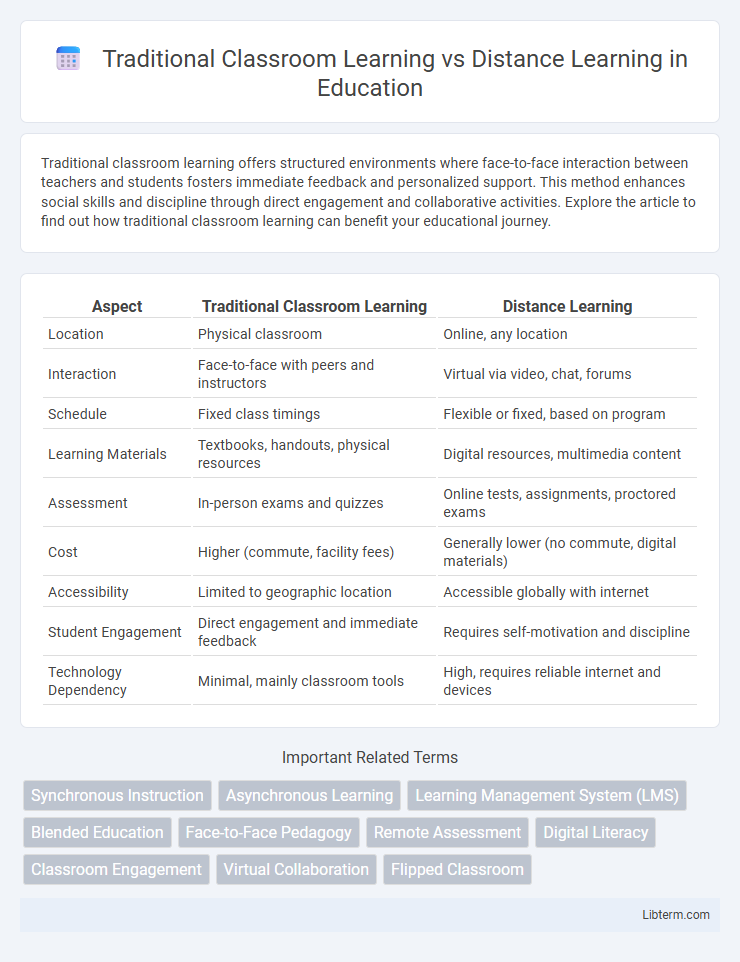Traditional classroom learning offers structured environments where face-to-face interaction between teachers and students fosters immediate feedback and personalized support. This method enhances social skills and discipline through direct engagement and collaborative activities. Explore the article to find out how traditional classroom learning can benefit your educational journey.
Table of Comparison
| Aspect | Traditional Classroom Learning | Distance Learning |
|---|---|---|
| Location | Physical classroom | Online, any location |
| Interaction | Face-to-face with peers and instructors | Virtual via video, chat, forums |
| Schedule | Fixed class timings | Flexible or fixed, based on program |
| Learning Materials | Textbooks, handouts, physical resources | Digital resources, multimedia content |
| Assessment | In-person exams and quizzes | Online tests, assignments, proctored exams |
| Cost | Higher (commute, facility fees) | Generally lower (no commute, digital materials) |
| Accessibility | Limited to geographic location | Accessible globally with internet |
| Student Engagement | Direct engagement and immediate feedback | Requires self-motivation and discipline |
| Technology Dependency | Minimal, mainly classroom tools | High, requires reliable internet and devices |
Introduction to Learning Modalities
Traditional classroom learning centers on face-to-face interaction, fostering direct engagement between students and instructors within a structured environment. Distance learning leverages digital platforms, enabling flexible access to educational content regardless of geographic location. Both modalities offer distinct advantages in accessibility, communication, and resource utilization tailored to varied learner preferences and needs.
Defining Traditional Classroom Learning
Traditional classroom learning involves face-to-face instruction where students and teachers interact in a physical classroom setting, providing immediate feedback and hands-on activities. This method emphasizes structured schedules, direct communication, and social engagement, supporting collaborative learning and real-time discussions. Traditional classrooms foster an environment rich in sensory experiences and personal connections that enhance student motivation and accountability.
What is Distance Learning?
Distance learning is an educational method where students access course materials and instruction remotely through digital platforms, eliminating the need for physical presence in a traditional classroom setting. It utilizes technologies such as video conferencing, online discussion forums, and learning management systems to facilitate interactive and flexible learning experiences. This mode of education supports diverse learning styles and offers accessibility for students regardless of geographic location.
Key Differences Between Traditional and Distance Learning
Traditional classroom learning involves face-to-face interaction in a physical setting, fostering immediate feedback and social engagement among students and instructors. Distance learning utilizes online platforms to deliver educational content remotely, allowing flexibility in time and location but requiring higher self-discipline and digital literacy. Key differences include the mode of communication, learning environment, and degree of personal interaction, which impact student motivation and accessibility.
Benefits of Traditional Classroom Learning
Traditional classroom learning fosters direct interaction between students and instructors, enhancing immediate feedback and personalized support. It cultivates social skills and teamwork through face-to-face collaboration and group activities, creating a structured environment that promotes discipline and consistent study habits. The physical presence in a classroom setting also reduces distractions, leading to increased focus and engagement during lessons.
Advantages of Distance Learning
Distance learning offers unparalleled flexibility, allowing students to access course materials anytime and anywhere, which supports varied learning paces and schedules. It reduces costs related to commuting and housing, making education more affordable and accessible to a broader range of learners worldwide. Advanced digital platforms enhance interactive experiences through multimedia content, forums, and real-time feedback, fostering personalized and collaborative learning environments.
Challenges of Both Learning Approaches
Traditional classroom learning faces challenges like limited flexibility, fixed schedules, and potential for distractions in physical settings, which can hinder individualized pacing and accessibility for diverse learners. Distance learning often struggles with technological barriers, reduced social interaction, and difficulties in maintaining student engagement, leading to potential gaps in motivation and comprehension. Both approaches require adaptive strategies to address varying learner needs and optimize educational outcomes.
Impact on Student Engagement and Interaction
Traditional classroom learning fosters direct, face-to-face interaction, enhancing immediate feedback, non-verbal communication, and collaborative activities that boost student engagement. Distance learning relies heavily on digital tools, which can create barriers to spontaneous interaction and reduce opportunities for peer collaboration, potentially impacting motivation and active participation. However, carefully designed online platforms with interactive features like discussion forums, live chats, and multimedia resources can partially mitigate engagement challenges inherent in remote education.
Technology’s Role in Modern Education
Technology in modern education enhances both traditional classroom learning and distance learning by providing interactive tools, digital resources, and real-time communication platforms. In traditional classrooms, smartboards, tablets, and educational software facilitate collaborative and personalized learning experiences, while distance learning relies heavily on video conferencing, learning management systems, and online assessments to deliver curriculum remotely. The integration of technology bridges gaps between these modalities, fostering accessibility, engagement, and adaptive instruction tailored to diverse student needs.
Choosing the Right Learning Method
Selecting the optimal learning method depends on individual goals, learning styles, and access to resources. Traditional classroom learning offers structured environments, face-to-face interaction, and immediate feedback, which benefit learners needing direct engagement. Distance learning provides flexibility, diverse course options, and self-paced study, ideal for those balancing education with work or personal commitments.
Traditional Classroom Learning Infographic

 libterm.com
libterm.com